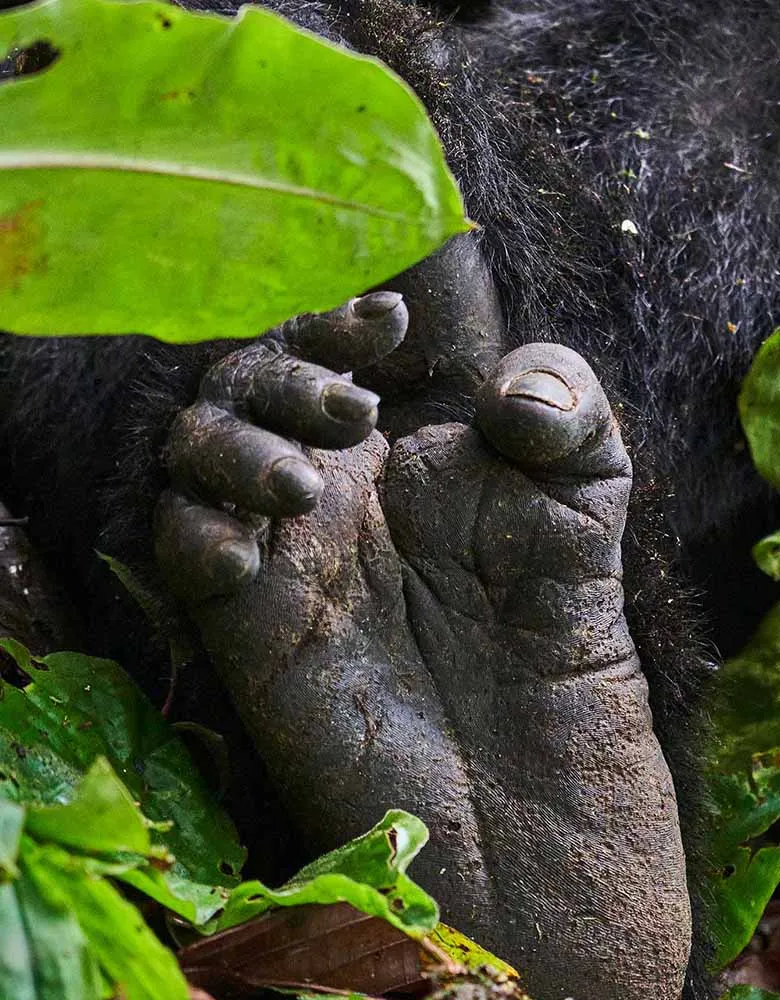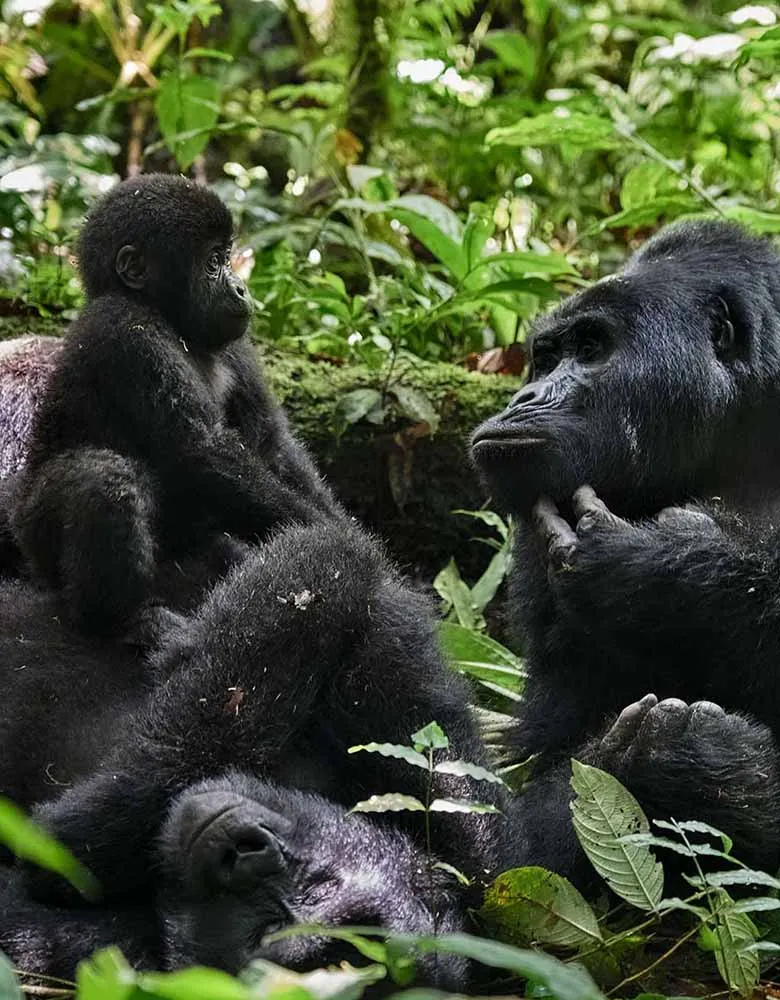Plot 2- Colvile Street Shumuk building Suite No. 43
Welcome to Uganda, the best place in Africa to see gorillas up close! Our Gorilla Tours & safari expeditions take you to the remote southwestern region, where you can witness the incredible mountain gorillas in the misty mornings. The rural landscape boasts world-class forest lodges that offer idyllic settings, giving you priceless moments with the enchanting gorilla families. With two national parks available for gorilla trekking, five visitor centers, and over half of the last endangered mountain gorilla population, Uganda is the ideal destination for your once-in-a-lifetime experience with Africa’s gorillas. Let our local specialists help you plan your gorilla expedition.
If you’re an animal lover or avid safari-goer, you simply can’t miss the unmatched up-close encounters with Africa’s gorillas on these treks. To help you plan your expedition, we’ve compiled a list of our best gorilla safaris in Africa. Take a look!



In Uganda, visitors on tour can experience gorillas in two different ways. The first is the regular gorilla trekking, which allows visitors to spend an hour with a fully human-habituated troop. Alternatively, visitors can opt for the Gorilla Habituation Experience, which allows them to spend at least four hours with a semi-habituated (wild) group accompanied by researchers and rangers. Both gorilla expeditions are truly immersive.
The great apes of tropical Africa are undeniably fascinating. Their sheer size is impressive and captivating, even to someone who may be tired or overwhelmed. Watching mountain gorillas is a truly emotional experience.
The combination of immense strength and gentle nature, along with strong social bonds, connection to the environment, vulnerability, and struggle for survival, leaves visitors feeling humbled. It’s amazing to see how similar these basic primates are to humans, both in appearance and behavior.
In fact, the DNA difference between humans and gorillas is only about 1.6%. In the past, we didn’t fully appreciate the fascinating lives of these great apes, and popular media only fueled fear and misunderstanding. Now, more and more people are seeking an authentic experience in the tropical forests of East-Central Africa, on unforgetable gorilla expeditions, rather than settling for a behind-the-cage exhibition at the zoo.
Tourists can now experience unforgettable moments with Africa’s giant primates by booking tours to see gorillas in East Africa’s Uganda, Rwanda, or DRC. This is made possible by the success of the gorilla conservation program, which is supported by gorilla tourism and sustainable community programs.
Tours to see gorillas in Uganda start from any of UWA’s five visitor centers or park management quarters in the early misty-morning hours. Since the national parks are far from the International Airport (about 310 mi/500 km), you must spend a night near the park entrance to join the early morning forest experience. Fortunately, several idyllic safari lodges surround the visitor centers.
Uganda offers exceptional opportunities to see gorillas in their natural habitat, with renowned locations, Bwindi Impenetrable Forest and Mgahinga Gorilla National Park, providing unforgettable gorilla trekking tours.

Bwindi is a 25,000-year-old oasis of 331 square kilometres (128 sq mi) pristine rainforest with a vibrant ecosystem. It has 19 gorilla groups available for tourism in four sections (Nkuringo, Buhoma, Rushaga, and Ruhija Sectors) spread over the park’s four corners. Visitors can access the park by domestic flights from Entebbe or by a 10-hour scenic drive.

Mgahinga National Park is on Uganda’s side of the Virunga Mountains, shared with Rwanda and DRC. The 33.9-square-kilometer (13.1 sq mi) park conserving the slopes of Muhavura, Gahinga, and Sabinyo dormant volcanoes, is Uganda’s smallest reserve. Apart from trekking gorillas, the park offers golden monkey tracking, hiking, and birding adventures.
Unlike big-city tours and overland adventures, planning a gorilla tour in Uganda requires Destination Management Company to buffer you against the local logistical dilemmas.
Our local gorilla safari specialists will book your trekking permits, organize your transfers between places, and recommend the best accommodations from our selection of properties we have visited and trust to host our type of customer.
Working with us ensures that you get the best recommendation on when to travel for the gorilla expedition, what to pack, and how to shape your expectation of traveling in remote African country for the first time.
Forest resorts in these destinations are pristine, often with dramatic views of jungle canopies and rugged landscapes, transporting guests to idyllic enchantments excellent for tours to see gorillas in Africa.
Our selection of great safari lodges for gorilla trekking includes meals with accommodation, often all meals during your stay.
Usually, you have to book into a hotel near the airport, spend a night and dedicate the next day to traveling across to gorilla country. You’ll spend a minimum of two nights in Bwindi, allowing you to save an entire day for the gorilla trekking experience.
The costs of a gorilla trekking safari in Uganda are basic and knowing where your money will be spent will help you comfortably plan your trip.
Gorilla Trekking Permit (Foreigners – $700, Resident foreigners $600)
Gorilla Habituation Permit ($1500)
Transport & Transfer Costs ($240 – $350 per day)
Domestic Flights ($500 – $700 pp return)
Accommodation & Meals ($170 – $1500 per night, full board)
Logistical Support Fees (relative)

Nkuringo/Rushaga Sectors
Luxury Lodge
From $230 pp single fb.

Buhoma Sector
Luxury Safari Camp
From $315 pp sharing fb

Buhoma
Luxury Lodge
Price range: USD 300

Nkuringo Sector
Luxury/high-end
Lodge Price range: USD 490—1085

Buhoma Sector
Mid-range
Price range: USD 380

Buhoma Sector
Luxury chalets
Price: From $480 pp

Rushaga or Nkuringo Sector
Mid-range Lodge
From $155 pp single fb.

Nkuringo/Rushaga Sector
Mid-range price
From $125 pp sharing fb.

Buhoma Sector
Budget Lodge
From $216 pp single fb.
How gorilla tourism sustains local communities
When you book gorilla trekking tours in Uganda, you contribute directly to the species’ survival and sustain poor communities around conservation areas with alternative livelihoods.
Please contact our office at info@africapleasantsafaris.com for information about our programs that support communities around gorilla habitats.
Much of the mountain gorilla habitats overlap with impoverished, remote communities. People depended on the rainforests long before conservation as an essential source of fuel and food.
Their historical lands are now closed off, and they would be justified to consider gorillas a threat to their living. One of the most crucial factors for effective conservation is helping poor communities benefit from conservation programs.
The Uganda Government, through its conservation bodies, gives back twenty percent (20%) of every gorilla permit fee to the surrounding communities to develop infrastructure and create alternative livelihoods.
Despite considerable limitations, gorilla conservation through the tourism model has largely been successful for years.
Revenues from selling gorilla tracking permits have powerfully impacted their long-term outlook.
Ugandan locals are employed directly in the gorilla tours as guides, rangers, porters, service providers at lodges, souvenir artists, and many other employments around your successful encounter with the gorillas.
Tours in Uganda (and Rwanda) are highly developed and professionally organized.
The best time to go gorilla trekking in Uganda is during the dry seasons, specifically from January to February and June to September. This ensures that you won’t encounter heavy rainfall and that the roads will be smoother, although there is still a possibility of rain or muddy conditions. However, it’s important to note that the peak season, which coincides with the dry season, presents some challenges in securing gorilla permits and finding available accommodations. Therefore, make your bookings well in advance, preferably 4-6 months or even a year ahead.
On the other hand, the low season, spanning from September to November and March to May provides discounted rates for gorilla expeditions in Uganda but comes with guaranteed downpours, typically lasting up to two hours each day. Nevertheless, the views during this time of year are breathtaking. Additionally, during the dry season, Uganda gorilla tours often extend for wildlife game viewing in the savannah parks, as animals tend to gather around water sources. Bird watching is also exceptional all year round, particularly from November to April when migrant species are present. Even during the rainy season, April and May are excellent periods for birding during your trip.
Gorilla habituation offers a longer and more immersive experience, with up to four hours spent observing and interacting with a gorilla family not fully familiarized with humans. However, it’s more expensive at US $1,500 per permit per person, and only four tourists are allowed to participate. The experience is limited to the Rushaga sector of Bwindi Impenetrable National Park. Gorilla trekking costs USD 700 per permit per person, and visitors are allowed only one hour with a gorilla family fully accustomed to human presence.
Uganda and Rwanda gorilla permits are non-refundable and non-transferable since your passport details are checked against the ticket. If you cancel your gorilla tour or fail to turn up on the tracking day, you can not get your money back for whatever reason. However, you or your tour operator can reschedule the permit to another date up to a week before the tracking date. You can book the gorilla permit up to two years before the trekking date. You must pay at least 30% of the permit price at reservation time, remit the balance less than 90 days before the trekking date, or lose the 30% deposit and the permit. However, if you must cancel your booking, you must incur expenses.
Uganda gorilla expeditions can be quite expensive due to the cost of the gorilla permits, which serve as a vital conservation funding tool. Approximately 75% of the fees generated from these permits are allocated towards human resources and conservation initiatives. Additionally, a portion of the funds goes towards developing infrastructure and creating income opportunities for the communities residing near the parks.
The individuals responsible for security, healthcare, and trekking services endure extremely challenging and remote conditions, often spending extended periods away from their families. Despite these hardships, gorilla safari lodges located in these remote areas go above and beyond to provide luxurious amenities to their guests. While these factors contribute to the higher cost of gorilla expeditions, they are necessary for the success of gorilla conservation efforts and to ensure truly unforgettable encounters with these magnificent creatures.
You should definitely hire a porter on your gorilla trek. The trek is quite tuff for many people. Porters are very useful in helping you navigate challenging terrain by pulling your hand, pushing you up steep slopes, and sometimes carrying you when injured. They also hold your pack or gear, so the hike through high altitude is smooth and pleasant. On a responsible travel note, hiring a porter is an excellent way to support the local communities directly. The men and women offering their services as porters come from remote villages that would be looking at the rainforest for livelihood. The 20 bucks you pay can support an entire family for almost twenty days, which is quite something for low-income families living near gorilla habitats.
Sign up and get the best deals straight in your inbox!
WhatsApp us